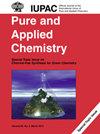自动生产[Fe18FF2(BnMe2-tacn)]并研究与高活性[18F]F-一起使用的放射性稳定剂
IF 2
4区 化学
Q3 CHEMISTRY, MULTIDISCIPLINARY
引用次数: 0
摘要
在 EtOH 水溶液中使用 18F- 对 [FeF3(BnMe2-tacn)](tacn = 1,4,7-三氮杂环壬烷)进行人工放射性氟化和纯化的方法已转化为通用电气 FASTLab™ 自动合成平台,并通过进行一系列低活性放射性标记实验进行了优化,以探索改变前体浓度、温度、加热时间、NaOAc 缓冲溶液添加量和 EtOH:H2O 比例的影响。最佳条件是将 1 毫克/毫升的前体在含有 18F- 的 75%:25% EtOH:H2O 溶液中于 120 °C 下加热 10 分钟,并使用 10 毫摩尔 NaOAc 进行洗脱,从而获得 61% 的放射化学产率(RCY)。然后,测试了抗坏血酸钠、烟酰胺和对苯甲酸 (pABA) 作为该系统的潜在放射性稳定剂,最初使用的是低活性 18F-。这些实验表明,在抗坏血酸钠存在的情况下,放射性产物的脱氟速度非常快。相比之下,烟酰胺和 pABA 似乎是有效的辐射稳定剂,2 小时后的 RCP 值分别为 91% 和 89%,而在没有它们的情况下,t = 2 小时的类似条件下的 RCP 值为 81%。然后进行了高活性实验,加入 5 毫克/毫升烟酰胺(放射性活性浓度 (RAC) 为 220 MBq/毫升),得到的 RCY 为 26%,纯化后,[Fe18FF2(BnMe2-tacn)] 产物在 t = 0 时的 RCP 值为 97%,3 小时后为 86%。本文章由计算机程序翻译,如有差异,请以英文原文为准。
Automating the production of [Fe18FF2(BnMe2-tacn)] and investigating radiostabilisers for use with high-activity [18F]F−
The manual radiofluorination and purification of [FeF3 (BnMe2 -tacn)] (tacn = 1,4,7-triazacyclononane) using 18 F− in aqueous EtOH has been translated to a GE FASTLab™ automatic synthesis platform and optimised by conducting a series of low-activity radiolabelling experiments to explore the effects of varying the precursor concentration, temperature, heating time, addition of NaOAc buffer and EtOH:H2 O ratio. The optimal conditions were determined to be 1 mg/mL of the precursor being heated at 120 °C for 10 min in 75 %:25 % EtOH:H2 O containing 18 F− , with elution using 10 mM NaOAc, giving 61 % radiochemical yield (RCY). These conditions were then employed with high-activity 18 F− giving a 97 % radiochemical purity (RCP) at t = 0, which decreases by 22 % over 5 h. Sodium ascorbate, nicotinamide and p -benzoic acid (p ABA) were then tested as potential radiostabilisers for this system, initially using low-activity 18 F− . These experiments revealed very rapid defluorination of the radioproduct in the presence of sodium ascorbate. In contrast, both nicotinamide and p ABA appear to be effective radiostabilisers, resulting in RCP values of 91 % and 89 %, respectively, after 2 h, which compare with an RCP of 81 % under analogous conditions at t = 2 h in their absence. High-activity experiments were then undertaken with addition of 5 mg/mL of nicotinamide, with a radio-active concentration (RAC) of 220 MBq/mL, giving RCY of 26 % and following purification, RCP values for the [Fe18 FF2 (BnMe2 -tacn)] product of 97 % at t = 0 and 86 % after 3 h.
求助全文
通过发布文献求助,成功后即可免费获取论文全文。
去求助
来源期刊

Pure and Applied Chemistry
化学-化学综合
CiteScore
4.00
自引率
0.00%
发文量
60
审稿时长
3-8 weeks
期刊介绍:
Pure and Applied Chemistry is the official monthly Journal of IUPAC, with responsibility for publishing works arising from those international scientific events and projects that are sponsored and undertaken by the Union. The policy is to publish highly topical and credible works at the forefront of all aspects of pure and applied chemistry, and the attendant goal is to promote widespread acceptance of the Journal as an authoritative and indispensable holding in academic and institutional libraries.
 求助内容:
求助内容: 应助结果提醒方式:
应助结果提醒方式:


